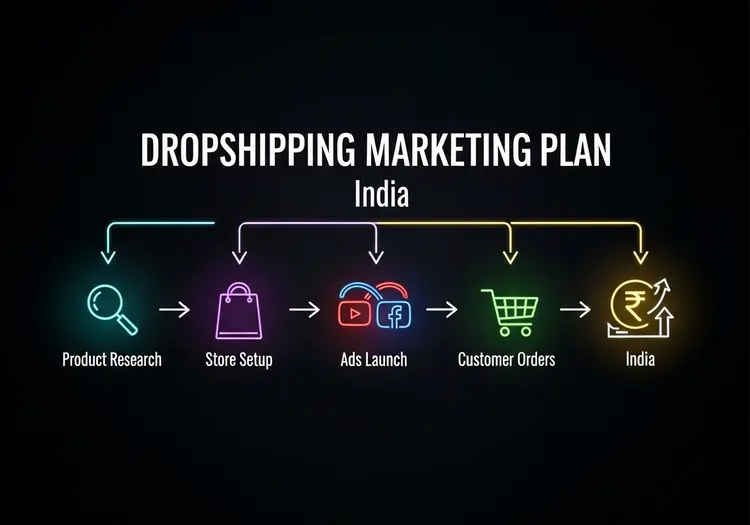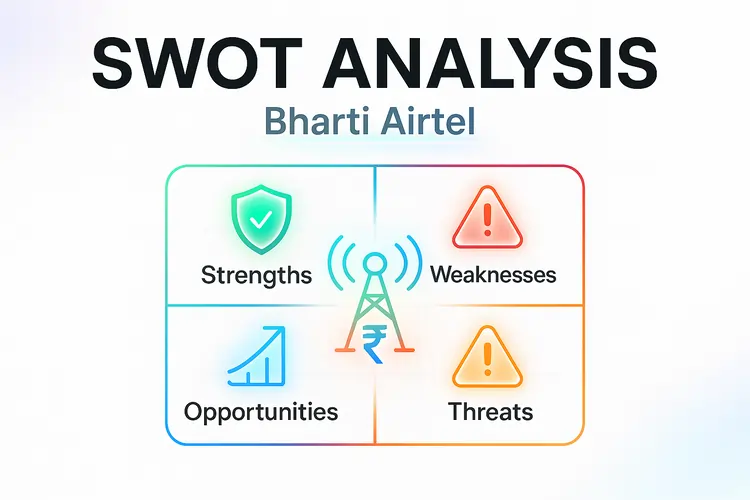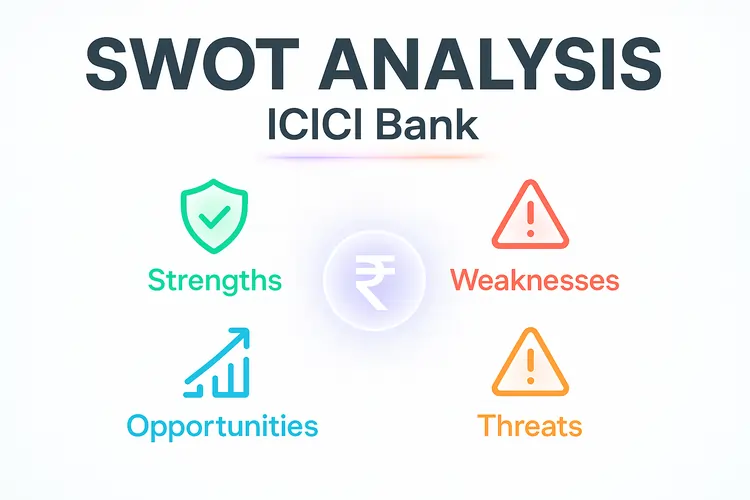Dropshipping marketing plan is the single most important step between a struggling store and a profitable one. In India, where e-commerce sales are projected to cross US$160 billion by 2025 (IBEF), running ads without a clear plan is like burning money.
At The DM School, we’ve seen this play out across 1 Lakh+ students and clients. Deepak Singh, Founder — The DM School (Google Partner Digital Marketing Agency), has managed ₹10 Cr+ in ad spend and scaled businesses to ₹100 Cr+ in revenue. That proof gives weight to every strategy you’ll read here.
Unlike generic Shopify templates, this guide breaks down an India-specific dropshipping marketing plan with real ad cost benchmarks, WhatsApp marketing strategies, and a 90-day roadmap designed for Indian entrepreneurs. You’ll see how to align product research, ads, and funnels into a repeatable system.
Table of Contents
Summary: This guide gives you a complete, India-first dropshipping marketing plan with steps, tools, and timelines.
Now you can plan your business with precision instead of guesswork.
What is a Dropshipping Marketing Plan?
Quick Answer: A dropshipping marketing plan is a step-by-step strategy that defines how your store attracts traffic, converts customers, and scales profitably using ads, SEO, and funnels.
A dropshipping marketing plan is more than a checklist — it’s the roadmap that guides product selection, ad campaigns, pricing, and customer engagement. Without it, most stores fail within months, especially in India where competition is rising fast.
Globally, the dropshipping industry was valued at USD 365.67 billion in 2024 and is projected to reach USD 1.25 trillion by 2030, growing at a CAGR of over 22% (Grand View Research). This growth proves why structured marketing is no longer optional — it’s the foundation of sustainable profit.
Snapshot: A dropshipping marketing plan ensures every rupee spent on ads brings measurable returns. In India, this often means blending Facebook Ads, WhatsApp campaigns, and SEO into one connected system.
Summary: A dropshipping marketing plan is your profit blueprint.
Now you can see why starting without one is a guaranteed loss.
Why a Marketing Plan Matters for Dropshipping in India
India is one of the fastest-growing e-commerce markets in the world. By 2025, the sector is expected to cross US$160 billion (IBEF) and may even reach US$188 billion (Grant Thornton). Bain & Company notes that India already has the world’s second-largest online shopper base, with over 60 crore users buying online.
In the last three years alone, 125 million Indians became new online shoppers. Another 80 million are expected to join by 2025, with rural buyers growing at 22% CAGR (IBEF). This surge creates massive opportunity — but only for businesses with a structured dropshipping marketing plan.
Mistake to Avoid: Many new dropshippers launch stores and run ads blindly. Without a clear marketing plan, high ad costs quickly wipe out profits — a mistake we see often at Digital Marketing Services in Delhi.
The lesson is clear: the opportunity is real, but so is the competition. If you don’t plan your ad spend, product positioning, and customer journey, someone else will take your market share.
Summary: India’s e-commerce is exploding, but only planned dropshipping stores survive.
Now you can see why skipping strategy means skipping success.
Core Elements of a Profitable Dropshipping Marketing Plan
A dropshipping marketing plan works only if its foundation is strong. Here are the four core elements that decide whether your store becomes profitable or fades away.
1. Niche & Product Research
Winning stores pick products that solve a problem or ride a trend. Use tools like Google Trends and marketplaces like Meesho or Flipkart to validate demand before investing in ads.
2. Reliable Suppliers
A profitable marketing plan collapses if suppliers fail. Look for Indian suppliers on platforms like IndiaMart or direct tie-ups with manufacturers for faster delivery.
3. Pricing & Margins
Most Indian dropshippers start with ₹8,000–₹10,000 setup cost, excluding ads (Qikink). Factor at least 20–30% margin to survive ad spends and payment gateway fees.
4. Marketing Channels
From Facebook Ads in India to SEO and WhatsApp, your channels decide whether you get leads at ₹30 or ₹300. Choose 2–3 core channels and master them instead of spreading thin.
These elements are non-negotiable. Get them right, and scaling becomes easier; skip them, and no ad strategy can save you.
Summary: Profitable dropshipping starts with niche, suppliers, pricing, and channels.
Now you can build your plan on solid ground.
Advanced Strategies: Ads, Funnels & Competitor Research
Once the basics are in place, your dropshipping marketing plan must move beyond templates. In India, ad platforms, funnels, and customer touchpoints make or break profits.
Paid Advertising Strategy
On Instagram, CPC ranges from ₹1–₹6 and CPM between ₹7–₹13 per 1,000 impressions (GotoClan). Compared to global CPMs of ₹650+, Indian ads remain affordable — but only if campaigns are optimized. Running broad campaigns without testing can kill margins quickly.
🔥 Pro Tip: Test at least 3 creatives per ad set and kill underperformers within 48 hours. Scaling winners early lowers your long-term CPM by 20–30%.
WhatsApp + Instagram Integration
With over 535 million active users in India (Meetanshi), WhatsApp is the most underrated dropshipping channel. Smart stores use Instagram ads to drive WhatsApp leads, then close sales through personalized messages, order reminders, and COD confirmations.
Funnel Building & Retargeting
A winning funnel blends ads, landing pages, and remarketing. Instead of sending users to a generic website, direct them to a focused landing page built for conversions. Retarget non-buyers with dynamic product ads to maximize ROI.
Competitor Platform Comparison
Unlike global guides that only push Shopify, Indian sellers often compare Shopify, WooCommerce, and Dukaan. Shopify is flexible but costly; WooCommerce works well if you control hosting; Dukaan is fast for India-first entrepreneurs. Choose the platform that balances budget, customization, and local payment integrations.
Summary: Advanced marketing blends ads, funnels, and platform choices with India-first tactics.
Now you can scale beyond basics with confidence.
Common Myths About a Dropshipping Marketing Plan
Many beginners avoid building a dropshipping marketing plan because of myths spread online. Let’s crush the biggest misconceptions holding back Indian entrepreneurs.
❌ Myth 1: “Dropshipping is Dead in 2025”
Reality: The global dropshipping market is growing at 22% CAGR and will hit USD 1.25 trillion by 2030 (Grand View Research). In India, e-commerce is still expanding with 125 million new shoppers in the last 3 years. Dropshipping is evolving, not dying.
❌ Myth 2: “Ads Are Too Expensive in India”
Reality: Instagram CPC in India averages only ₹1–₹6 and CPM ₹7–₹13. Compare this with global CPMs at ₹650. With a proper marketing plan, Indian dropshippers can acquire customers at a fraction of global costs (Facebook Ads in India Guide).
❌ Myth 3: “I Can Run a Store Without a Plan”
Reality: Most unplanned stores fail within months. Without niche research, funnel design, and retargeting, ad costs skyrocket. A structured plan ensures every rupee spent generates measurable returns.
❌ Myth 4: “Dropshipping Is Easy Money”
Reality: Dropshipping is not a get-rich-quick scheme. It needs research, ad optimization, and customer engagement. But with a strong dropshipping marketing plan in India, entrepreneurs can build businesses earning ₹30K–₹1.5L per month.
Summary: Myths kill more dropshipping stores than competition.
Now you can move forward with facts, not fears.
Tools & Platforms for Dropshipping Marketing in India
No dropshipping marketing plan works without the right tools. From store setup to ads and analytics, these platforms decide your efficiency and cost structure.
E-commerce Platforms
Indian dropshippers usually pick between Shopify, WooCommerce, and Dukaan. Shopify offers global apps but higher monthly fees. WooCommerce is flexible for those comfortable with hosting. Dukaan is India-first with UPI integrations and COD support.
| Platform | Strength | Best For |
|---|---|---|
| Shopify | Global ecosystem, apps, themes | Scalable stores with budget |
| WooCommerce | Customizable, works on WordPress | Entrepreneurs with hosting control |
| Dukaan | India-first, UPI & COD ready | Quick launch, low-tech setup |
Marketing Tools
For ads, use Facebook Advertising Services in India, Google Ads, and Instagram Ads Manager. For creatives, Canva works well for beginners while Figma helps teams. For SEO, tools like Ubersuggest and SEMrush simplify keyword research.
Analytics & Tracking
Google Analytics 4 remains the gold standard. Heatmap tools like Hotjar help you understand why visitors drop off. Unlike generic dropshipping blogs, adding analytics early saves thousands in wasted ad spend.
Summary: The right tools cut costs and increase speed.
Now you can choose platforms that fit your budget and skills.
90-Day Dropshipping Marketing Plan for Beginners in India
A solid dropshipping marketing plan should give you a step-by-step path. Instead of chasing random hacks, follow this 90-day roadmap designed for Indian entrepreneurs.
Phase 1 (Days 1–30): Setup & Research
Pick your niche, validate products, and set up your store. Start small with ₹8,000–₹10,000 setup budget. Focus on building a clean landing page and integrating COD + UPI payments.
Phase 2 (Days 31–60): Launch & Testing
Run Facebook and Instagram ads with 3–4 creatives each. Use WhatsApp automation for follow-ups. Remember: average conversion rates for e-commerce are just 2–3% (Shopify/BigCommerce). Don’t panic if only 2 out of 100 visitors buy.
Phase 3 (Days 61–90): Scaling & Optimization
Kill weak ad sets and scale winners. Introduce retargeting campaigns. Use analytics tools to track behavior. This is when you double down on what works and cut wasted spend. If you’re ready to scale faster, Book a Free Strategy Call with our team.
Stick to this plan and you’ll have your first profitable campaigns within 90 days — not years.
Summary: A 90-day plan makes dropshipping execution simple.
Now you can move from setup to scaling with confidence.
FAQs on Dropshipping Marketing Plan in India
How do I create a dropshipping marketing plan?
Start with niche research, reliable suppliers, and pricing. Add ad strategy, funnels, and tools. Break execution into a 90-day roadmap.
Is dropshipping profitable in India in 2025?
Yes. With India’s e-commerce market set to cross $160B by 2025, dropshipping can be profitable if planned with ads, WhatsApp, and funnels.
Which platform is best for dropshipping in India?
Shopify offers global flexibility, WooCommerce suits WordPress users, and Dukaan is India-first with UPI and COD integration.
How much investment is required to start dropshipping in India?
Startup costs are ₹8,000–₹10,000 excluding ads. With marketing tools and ad spend, budget ₹12,000–₹15,000 to launch properly.
How do I promote my dropshipping store in India?
Use Facebook and Instagram ads, SEO, and WhatsApp campaigns. Focus on retargeting, creatives, and product positioning for sustainable growth.
Conclusion: Build Your Dropshipping Marketing Plan Today
Every profitable store in India follows a structured dropshipping marketing plan. From niche research to ads and funnels, the roadmap you follow decides whether you make ₹30K a month or struggle with no sales.
Six months from now, you could look back at this moment as the day you stopped guessing and started executing. With India’s e-commerce market racing past US$160 billion, waiting only means letting others grab your share.
Don’t treat this guide as theory. Treat it as your action map. Follow the 90-day plan, use the tools, and avoid the mistakes we’ve crushed in the Objection Killbox. The businesses that scale in 2025 will be the ones with discipline, not luck.
If you’re serious about growing faster, Book a Free Strategy Call with our team at The DM School. We’ve helped hundreds of Indian entrepreneurs turn ideas into profitable stores, and we can help you do the same.
Summary: Dropshipping without a plan is gambling.
Now you can build a system that grows with clarity and confidence.


